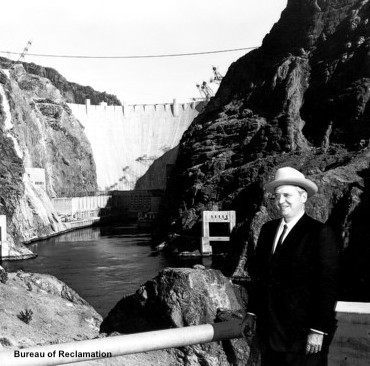Dublin Core
Title
Description
“I’ve seen all the wild rivers I ever want to see,” Floyd Dominy once said. As commissioner for the US Bureau of Reclamation during the 1960s, Dominy’s maximalist approach to dam building literally reshaped the American West. His view that rivers should be put to work faced direct opposition from a growing environmental movement, and that debate over harnessing rivers is still at the center of Western water politics.
After World War II, the booming population in the arid West needed its rivers to work harder than ever. The Bureau of Reclamation began coordinating region-wide projects to store water and generate hydropower, building dams by the dozen. Dominy quickly rose through the ranks of the Bureau, bringing with him gambling and womanizing habits better suited to a Wild West saloon than a Washington DC office. But Dominy proved himself a ruthless and efficient bureaucrat. Rather than let Congress set priorities for the Bureau, he turned the tables. Because he controlled Western dams – which meant water and jobs for their constituents – Dominy blessed his friends and withheld projects from those who dared question him. He reportedly said he "liked people the way we like animals: we like them, but we eat them."
The crown jewel of Dominy's plumbing empire was Glen Canyon Dam, which created Utah's Lake Powell. This reservoir stores water for seven states and generates electricity for customers as far away as Nebraska. Yet a burgeoning environmental movement challenged the Bureau’s utilitarian view of natural resources, and promoted Western rivers as sensitive and scenic ecosystems deserving protection. When Dominy won the day and Glen Canyon was flooded, he wrote a book to celebrate the reservoir, calling it the "Jewel of the Colorado." A disgusted Sierra Club president David Brower instead dubbed it “The World’s Biggest Septic Tank.”
Floyd Dominy racked up a considerable list of enemies, but was powerful enough that his favorite bargaining chip was threatening to quit. By 1969, however, Dominy’s reputation for personal excess caused President Nixon to pull the plug on his appointment. In his decade as commissioner, Dominy remade the American West by putting into place water infrastructure that Utahns use – and fight over – to this day.
Creator
Source
_______________
See Marc Reisner, Cadillac Desert: The American West and Its Disappearing Water (New York: Penguin, 1986); John McPhee, Encounters with the Archdruid (New York: Farrar, Straus and Giroux, 1971); Richard White, "It's Your Misfortune and None of My Own": A New History of the American West (Norman: University of Oklahoma Press, 1993); Floyd E. Dominy, transcript of tape-recorded Bureau of Reclamation Oral History Interviews conducted by Brit Allan Story, April 6, 1994 and April 8, 1996, National Archives and Records Administration; Tom Wolf, “‘Mr. Dominy, are you a hero or a villain?’” High Country News, Oct. 26, 1998; Douglas Martin, “F.E. Dominy, Who Harnessed Water in the American West, is Dead at 100,” New York Times, April 4, 2010.

